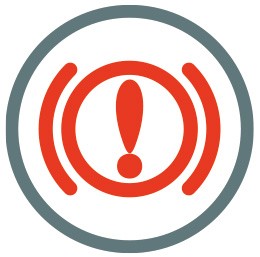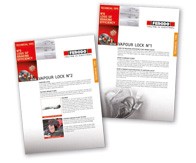-1749630340872.jpg)
A. BRAKE WARNING SYSTEM
In general, the dashboard light that indicates a problem with the brake system has an alarming red colour (depending on the vehicle model) to indicate that there is an immediate risk, potentially compromising the general safety of the vehicle. It should never be ignored.
There are several reasons why the brake system warning light may light up. The problem is that according to the survey mentioned below, almost half of the people on the road don’t recognise the risk and consequently don’t react accordingly.
MANY DRIVERS CAN’T IDENTIFY MISSION-CRITICAL DASH LIGHTS
According to a recent survey of 2,000 drivers asking them to identify definitions for 10 common dashboard lights, nearly half of the respondents weren’t able to tell what it would mean if their car’s tire pressure or brake system light flashed. Surprisingly, 17% of the respondents didn’t even know what the low fuel light means.
THE RESULTS OF THE SURVEY*:

Tire pressure warning 49%

Régulateur de vitesse activé 42 %

Brake system warning 46%

Fog beams activated 40%

RISK
- This will increase the risk of vapour lock.
WHAT TO DO?
- In case of a vapour lock, consult Technical Tips N°4 & N°5.
BRAKE PAD THICKNESS UNDER THE MINIMUM

RISK
This may gradually lead to brake pad underlayer contact with the brake disc and eventually – in the worst-case scenario – to back plate contact with brake disc.
WHAT TO DO?
Check brake pad thickness and replace if necessary in case of:
- Loud noise when applying brake pressure
- Serious damage to brake disc surface, caused by the steel back plate contacting the cast iron brake disc
- Vehicle pulling to one side due to unbalanced brake effect on both sides of an axle
FALSE READING DUE TO A PROBLEM IN A BRAKE SYSTEM PART (E.G. ABS)

RISQUE
Un anneau ABS rouillé ou brisé peut générer un signal erroné de l'arbre de transmission ou du roulement de roue. En cas de corrosion sous les vis de fixations du capteur, celui-ci peut être poussé plus près de l'anneau ABS et envoyer des indications erronées au module ABS.
QUE FAIRE ?
Vérifiez si les anneaux ne sont pas brisés ou rouillés dans l'ensemble du système ABS et remplacez-les, le cas échéant.
ALARME ERRONÉE CAUSÉE PAR LA SENSIBILITÉ EXCESSIVE DU SYSTÈME D'AVERTISSEMENT DES FREINS
RISQUE
Le témoin d'avertissement du tableau de bord continue à s'allumer, même après avoir changé les plaquettes et les témoins d'usure correspondants.
QUE FAIRE ?
- Enfoncez plusieurs fois la pédale de frein pour assurer un contact entre les plaquettes et les disques de frein.
- Éteignez le tableau de bord pendant quelques secondes.
- Remettez le contact et vérifiez si le témoin est toujours allumé sur le tableau de bord.
Si le témoin d'avertissement des freins reste allumé, demandez l'aide d'un expert.
Ce type d’alarme erronée peut être fréquent sur certaines marques et certains modèles. Consultez ces modèles en ligne sur le site www.ferodo.fr. Et si vous rencontrez des problèmes plus fréquents sur un modèle particulier, dites-le nous.
IMPORTANT : certains modèles sont dotés d'un indicateur d'usure « à deux niveaux », 70 % et 100 %.